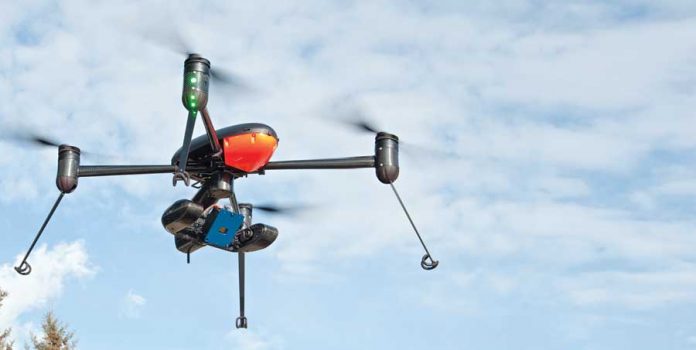Right now, the robot can pick apples, peaches, plums and other fruits that can be plucked for a stem
A solution to a shortage of labourers may be flying robots for picking fruit that has emerged alongside a steadily growing population and an increasing demand for food.
To make the flying fruit pickers a reality, Tevel, the start-up behind the flying autonomous robots, has worked for four and a half years developing the hardware and software.
“It’s a very smart robot,” Yaniv Maor, the CEO of Tevel Technologies Aerobatics said of the machine laden with artificial intelligence technology that calculates functions required for detecting, accessing and picking fruit.
“You need to understand how the robot will react to its surroundings and it needs to know, for instance, if there’s a human nearby,” Maor said.
Anywhere between 7 and 33 per cent of produce is left in the field each year, according to various estimates. The human population, beyond that is expected to reach 9.7 billion by 2050, meaning fruit production will have to double to meet demand.
The numbers point to a clear demand for a better way to mitigate food waste and provide for a growing population. Robots are one way to do it, but they take a long time to develop and right now, they’re expensive.
“We’re approaching the large farms in the beginning that face big challenges with labour,” Maor said.
By the end of this year, 200 robots will be autonomously collecting fruit, with currently, 20 robots in operation on two farms, one in Italy and one in the US.
Right now, the robot can pick apples, peaches, plums and other fruits that can be plucked for a stem.
“Once we solved it, the hardware is so simple. The software is complex, but for the hardware there’s not a lot of moving parts. We worked for five weeks with the hardware and we didn’t face any problems,” Maor said.
When asked if it was difficult to get the hardware and software to talk to each other, Maor said: “This is the process of integration. In the beginning nothing works, and after two weeks, it gets better, and by the fifth week it’s like ‘wow’.”
“We do not bruise the fruit as easily as humans and also the grading or determining the ripeness level is better than the human pickers by 15 per cent, and we get nearly all the fruit from trees,” he said. “So by these metrics we hit the bar for being commercial.”
For fruits like avocados where there’s a stem that must be cut, the hardware and software have to be adapted, and it’s not quite there yet.
“Maybe in a year,” Maor said when asked how long it will be until the robot can successfully pick an avocado.
Tevel is looking to raise $50 million as the company has just begun raising funds for its C stage operations.
Farm robotics start-ups raised a collective $491 million to automate everyday tasks, a 40 per cent increase from 2020 in the first half of 2021, according to AgFunder News. In general, robotics investment soared, with venture firms pumping $6.3 billion into robotics companies between March 2020 and March 2021, up 50 per cent from the $4.3 billion invested in the prior 12 months, according to an analysis by venture-capital database PitchBook for Forbes.
It doesn’t necessarily mean the money will be allocated as founders hope even with overall funding up. No formal statistics for the failure rate of robotics start-ups was found, but a flurry of articles titled along the lines of “Why robotics start-ups fail” indicates the issue is real.
A real concern for any start-up is falling into the so-called valley of death as they navigate successive fundraising rounds.
“Raising money for robotics it’s a big challenge, and it’s no less than the technological challenge,” he said. “And because of the technological challenge, it takes years to develop; you need funds to develop that.”
A report from Reach Robotics cited high engineering and talent costs, expensive materials, long sales cycles with expensive customer acquisition, and high support and maintenance costs post-delivery as some of the main reasons robotics start-ups fail.
So far, Tevel has raised $30 million in four and a half years, and once they complete the C stage round, they’ll look at expanding further geographically and look at how to adapt their product to pick more fruit. They’re even looking at how to make it operate in greenhouses and how to get the robot to sheer shrubs and trim trees.
Maor said they’re looking at the UAE as a prime location for expansion, eyeing the vertical farms the country is rapidly developing.
“The UAE is also an interesting market because this technology is a very smart arm. It can pick fruit, it can thin trees and branches, and we can integrate these robots into vertical farms and greenhouses,” he said.
Also read: CIO News interviews Shri Wangki Lowang, Minister (IT) of Arunachal Pradesh
Do Follow: CIO News LinkedIn Account | CIO News Facebook | CIO News Youtube | CIO News Twitter
About us:
CIO News, a proprietary of Mercadeo, produces award-winning content and resources for IT leaders across any industry through print articles and recorded video interviews on topics in the technology sector such as Digital Transformation, Artificial Intelligence (AI), Machine Learning (ML), Cloud, Robotics, Cyber-security, Data, Analytics, SOC, SASE, among other technology topic






